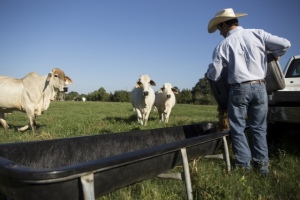By Jack Payne
Guest writer
If you’re a brewer and haven’t already done so, consider visiting a local cattle ranch. That’s not shilling for ranchers. It’s a business tip.
The Swamp Head Brewery in Gainesville feeds dozens of University of Florida cattle every time its crew makes a batch of Stump Knocker Pale Ale.
Our cattle drink it out of Hol-steins.
Sorry, couldn’t resist.
For two years, the UF Institute of Food and Agricultural Sciences Beef Teaching Unit in Gainesville has been supplementing its feed with the wet spent grains from one of our local microbreweries.
Here’s the way it works. The brewery makes daily batches of beer. One of the byproducts is spent grain, discarded after it has been used to produce a sweet liquid called wort. The wort is then boiled and transferred into a fermentation tank where yeast feed on the sugars and turn the wort into beer. An IFAS employee brings a pickup truck to the loading dock, loads several 32-gallon Rubbermaid buckets filled with the grains, and drives it the three miles back to the unit. It then gets mixed in with our forage as a nutritional supplement.
The best solutions address two or even three challenges at once, and that’s what we have here. In this simple transaction, we have multiple great results.
- Economic development: By selling its waste, a small business converts a cost for waste disposal into a revenue stream. That gives a locally-owned startup a boost.
- Environmental stewardship: IFAS’s purchase of the spent grain diverts several tons a week from the local landfill and instead puts it to use in support of beef production.
- Fiscal prudence: Feed costs account for 44 percent of the operating budget at our Beef Teaching Unit, by far its largest expense. The competitive price we get on the spent grains has reduced our feed bill substantially.
Luke Kemper, who owns Swamp Head, calls it a no-brainer. The way he sees it, why would he throw something in a landfill that another business could use? Although it helps his bottom line, it’s certainly not what makes or breaks his business. One of his company’s core values is sustainability.
Sending the grain to IFAS, Kemper says, is simply the right thing to do. I agree.
At the moment, we can take all the spent grains Swamp Head produces. We’re both small enough operations that we can adapt on the fly to production fluctuations. When we’re running low on feed, Swamp Head can brew an extra batch a day or two ahead of schedule. Conversely, when Swamp Head has a busy week, we’re able to take more than our usual supply. And our Brahmans don’t seem to mind whether we’re pouring the grains from a honey cream ale or an oatmeal coffee stout!
This might only work if you have a ranch in your community. But the explosive growth of the craft beer industry means the chances are better and better that you’ve set up shop somewhere that a rancher is looking for spent grains. According to the Brewers Association, 21 breweries opened in Florida in the past two years.
One thing you may have heard is that the Food and Drug Administration has proposed increasing regulations on brewers’ marketing of grain to animal producers. The beer industry opposed such regulations as unnecessary and costly. The FDA has yet to act on final regulations, but beer industry officials are cautiously optimistic that any rule changes won’t be burdensome enough to drive brewers to dump their spent grains in landfills.
Jesse Savell, an academic coordinator who runs the Beef Teaching Unit, recommends to the ranchers we serve that they analyze the spent grains for nutritional content and dry matter percentage before cutting a deal.
If the analysis yields good results, going with the grain can lower the rancher’s feed costs and raise a brewer’s profile as a recycler.
Cheers.
 Jack Payne is Senior Vice President
Jack Payne is Senior Vice President
for Agriculture and Natural Resources,
University of Florida Institute
of Food and Agricultural Sciences.





















